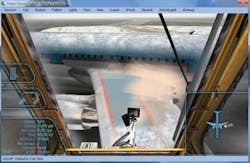As a weather-driven event, aircraft deicing allows for little practical training before operators are tested on the deicing pad. Evolving simulation technology has presented another training option.
It’s a tool that developers have claimed the benefits to include familiarizing operators with equipment and the deicing process without the dangers encountered on the ramp; reducing the cost associated with running equipment for training; as well as an opportunity to work on team dynamics.
From Computer to Cab
Global Ground Support LLC, a manufacturer of deicing trucks, rolled out its initial version in 2007. It began developing the simulator as an option for customers to familiarize themselves with its deicing trucks — and ultimately it has served as a selling advantage.
“We had a customer that required a simulator,” says Jeff Walsh, vice president of sales and service at Global Ground Support. “In order for us to bid on this large deicer purchase, we had to have a simulator.”
The company set out to create its own simulator, working with ForgeFx, a software development company. Since its inception, the simulator has undergone several updates, with the newest version due out in August 2009. It will feature the actual joysticks from Global deicing trucks, which Walsh says will enable the trainees to better acquaint themselves with operating the equipment. The newest version will also feature two more models of the company’s deicing trucks, the ER2875 and 2200 open bucket.
The company has also set a focus on improving the deicing experience. Walsh says the simulator now includes a fluid dynamics package and features ten models of aircraft. And the development goes on. The company is also working on adding a component to account for interplay between wind speed and fluid dispensation, according
to Walsh.
MPRI: gForce Products Division has also developed a simulator for the market. Rolling out the initial version in 2006, the company partnered with Vestergaard and JBT AeroTech to include its deicing equipment in the software. Apart from the equipment design, MPRI has also focused on upgrading the deicing experience.
“We started out approaching it as what we call a ‘part-task’ simulator,” says Jeffery Kleinsorge, program director of MPRI gForce Products. “You modify the joystick unit so that it can be plugged into a computer with a simulated airport environment. But then our next step was to actually focus on the deicing task. Now, in addition to becoming familiar with deicing equipment, you can actually use that deicer to melt the snow off an aircraft.”
The company has developed the simulator with a “physics engine,” which Kleinsorge says allows the program to be flexible and accurate to various situations.
Servisair initially implemented the gForce simulator at its central deicing facility at Toronto Pearson International Airport in 2006 for training on its Vestergaard Elephant Beta and Beta-15 deicing trucks. It has experienced the upgrades made to the software. “There are now 12 aircraft types we can select to train on. The graphics are much smoother,” says Chris Schock, deicing training supervisor for Servisair. “I guess the biggest selling feature is the physics package that they’ve implemented into it. Before basically the snow would come off in squares; now we can select variable amounts of both snow and ice, and it is a more accurate representation of how it really appears on the aircraft. The contamination will actually come off the aircraft surfaces how it does in the real world.”
Servisair has since added an additional simulator at the facility for two operators to use simultaneously to capitalize on the teamwork benefits. “It’s a team environment out there,” Schock says. “We want to promote and encourage that teamwork environment through team-based learning.
“It’s more efficient. On the simulator not only do we deice and simulate vehicle movement and positioning … we now can encompass many different aspects of the practical training curriculum on the simulator including communications and proper contamination removal techniques,” he says.
MPRI has continued to improve the technology and is currently working to accurately portray the “physical aspects” of weather, including precipitation and wind that could occur during deicing, according to Kleinsorge.
A larger trend
Another company has taken note of the benefits of simulated training for deicing. KaTron Inc., based in Turkey, is currently developing software for deicing. The simulation company has been in the business of developing technology for the defense aerospace industry, and looked to deicing as another opportunity.
“In our region what we learned was most of the airlines don’t have much opportunity for deicing, but to continue certifications, they have to do training every year ... the best solution is to get the training on the simulators,” says Tarcan Kiper, CEO of KaTron.
“We have a different design approach for deicing,” he says. “It’s not a desktop system, like a computer game. We build the replica of the actual equipment, but this replica equipment doesn’t sprout any chemicals; it’s on the virtual screen.”
KaTron has also developed a reconfigurable pushback simulator both for conventional and towbarless operations, and is expanding into other types of ground support equipment, says Kiper.
Simulation technology seems here to stay. Paul van Dinther of Dinther Product Design points out that the caliber of technology and the cost aspect make sense for an airline or ground handling company looking for training options. “Technology has advanced so much and so fast that these days a computer capable to run a full-blown visual system for big displays doesn’t cost the world anymore,” he says. “So the cost of equipment has come down a lot.”
* * *
(This article has been edited from the original, which originally appeared in Ground Support Worldwide. For more, visit www.groundsupportworldwide.com.)







